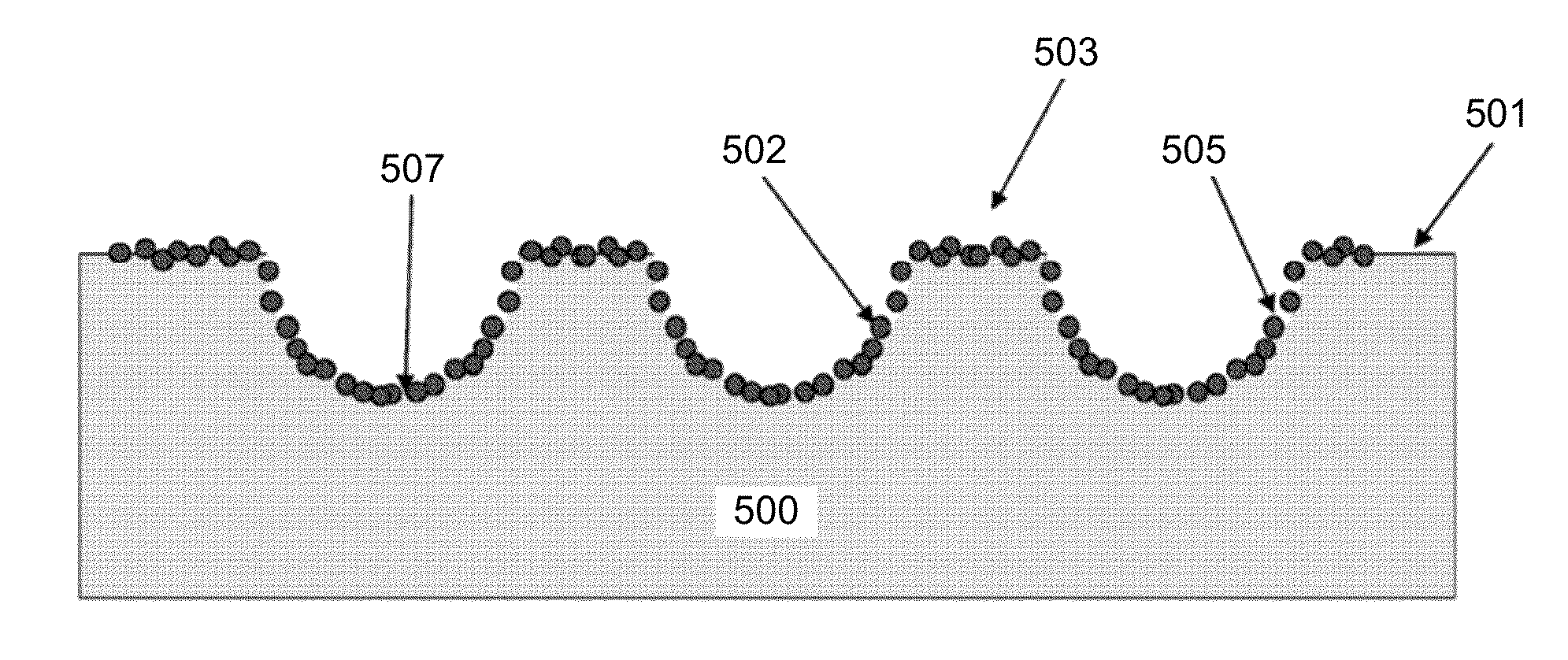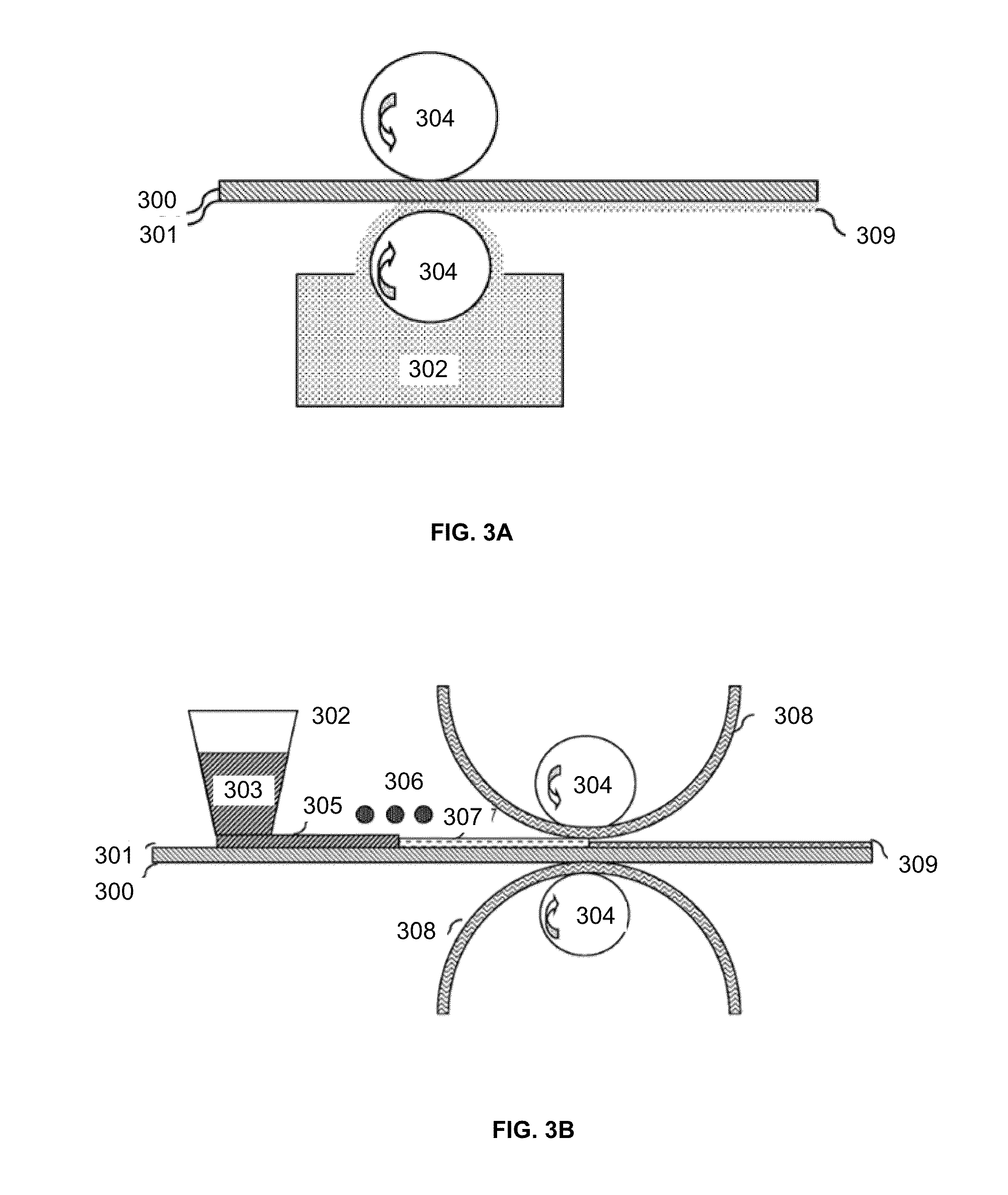Polymer having superhydrophobic surface
a technology of superhydrophobic surfaces and polymers, which is applied in the direction of roads, instruments, traffic signals, etc., can solve the problems of reducing the surface hydrophobicity, permanent loss of superhydrophobicity, and artificial superhydrophobic surfaces suffering from poor mechanical and/or chemical stability, etc., to achieve excellent mechanical properties, static and dynamic water pressure resistance, chemical resistance, and abrasion resistance. , the effect of simple and low-cost process
- Summary
- Abstract
- Description
- Claims
- Application Information
AI Technical Summary
Benefits of technology
Problems solved by technology
Method used
Image
Examples
example 1
Fabricating Polymer Sheets Having a Superhydrophobic Surface by Using a Template
[0116]Materials, methods and surface fabrication: A commercially available thermoplastic sheet of low density polyethylene (LDPE) manufactured by Berry Plastics (Evansville, Ind.) from 97% recycled polyethylene, 2% calcium carbonate and 1% slip oleamide and sold through McMaster-Carr was used as the polymer substrate. The thickness of the LDPE film was 100 micrometers and 10 layers of the LDPE film were used at each time to make free-standing superhydrophobic sheets that were approximately 1 mm thick. The polymer film softens at 106° C. and melts over the range from 113-120° C. Three types of stainless steel mesh (i.e., M1, M2, and M3) and one type of nylon mesh (i.e., M4) (all from McMaster-Carr) with different wire diameters and pore sizes were used as templates. The structures and details of the mesh are shown in Table 1 below.
TABLE 1Parameters of mesh templates for fabricatingsuperhydrophobic surface...
example 5
Test of a Superhydrophobic Surface Against Ice Accumulation
[0138]A superhydrophobic polymer film was made by laminating LDPE against a layer of nanoparticles (TS530) with a thickness of about 100 micrometers at 123° C. under a pressure of about 30 psi for 1 hour using the same process described in Example 3 except that a metal mat is placed between the lower plate of the press and the steel plate supporting the sheet of nanoparticles. The mat was used to distribute the pressure more uniformly, as is commonly done in plate lamination processing. A longer heating time was used as the mat impedes the conduction of heat from the plate to the polymer sheet. To test the icephobic properties of the superhydrophobic polymer film described above when exposed to small super-cooled liquid water droplets of average size (5-40 micrometers), the free-standing polymer film was placed on the windshield of a parked car overnight during an ice storm with its superhydrophobic surface exposing to air. ...
example 6
Fabricating Polymer Sheets Having a Superhydrophobic Surface by Using a Template Coated with a Porous Nanoparticle Layer
[0139]In this example, a template was coated with dry particles before a polymer sheet was laid atop the template. A commercially available thermoplastic sheet of low density polyethylene (LDPE) manufactured by Berry Plastics (Evansville, FN) and sold through McMaster-Carr was used as the polymer sheet. The polymer sheet contained 97% recycled polyethylene, 2% calcium carbonate and 1% slip oleamide. A nylon mesh with a pore diameter of 40 micrometers and a wire width of 40 micrometers was coated with silane treated nanoparticles (TS530, Cabot Corporation). During the coating treatment, the pores of templates were partially filled with the nanoparticles. The lamination of the polymer sheet with the template coated with nanoparticles was conducted at 123° C. under a pressure of 200 psi for 20 minutes. The cooling and peeling steps were the same as the procedures in E...
PUM
| Property | Measurement | Unit |
|---|---|---|
| size | aaaaa | aaaaa |
| length | aaaaa | aaaaa |
| distance | aaaaa | aaaaa |
Abstract
Description
Claims
Application Information
 Login to View More
Login to View More - R&D
- Intellectual Property
- Life Sciences
- Materials
- Tech Scout
- Unparalleled Data Quality
- Higher Quality Content
- 60% Fewer Hallucinations
Browse by: Latest US Patents, China's latest patents, Technical Efficacy Thesaurus, Application Domain, Technology Topic, Popular Technical Reports.
© 2025 PatSnap. All rights reserved.Legal|Privacy policy|Modern Slavery Act Transparency Statement|Sitemap|About US| Contact US: help@patsnap.com



